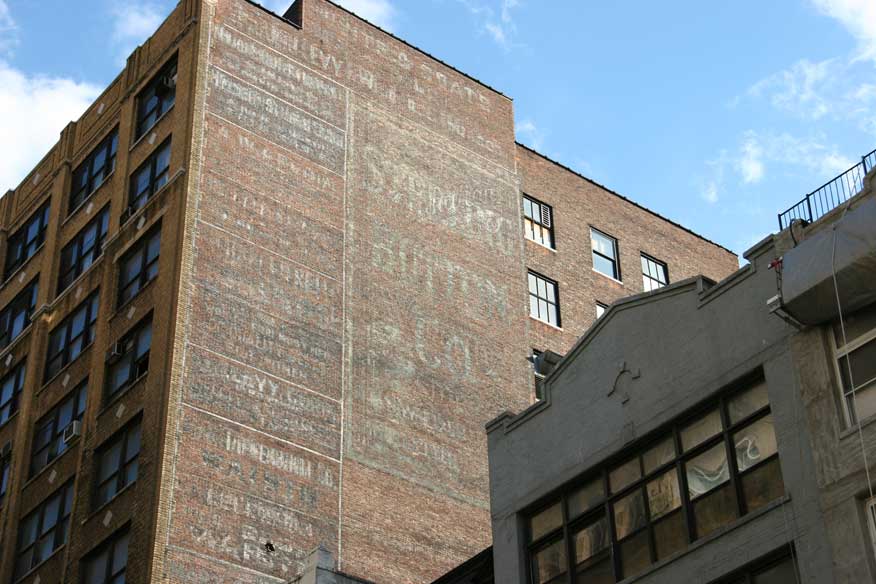
Sterling Button Co., etc., 8-14 W. 30th St. (2002)

The most prominent and readable sign here is Sterling Button Co.. Sterling Button was part of the Turkeltaub button and textile empire. Pater familias was Max Turkeltaub (1864-1969). Yes, these dates are accurate; Max lived to the age of 105. Sterling Button, also, was a story of longevity. Founded in 1904, they stayed in business until 1997 (long enough to be listed on websites such as TextileWeb). Max Turkeltaub was an immigrant from Russia in 1890 (naturalized 19 Oct. 1900). His obituary in the New York Times (16 June 1969, p. 47) says he "came to this country from Russia in 1889 [and] retired in 1944 from his button firm, Max Turkeltaub and Sons." He is first listed in New York city directories in 1897 as a button dealer at 174 Forsythe St. He is found in the U. S. Census of 1900 living downtown on East Broadway with wife and six children. Three of the children are sons: Nathan 16, Abie 14 and Bennie 12. Abie is Abraham Moses Turkeltaub (1883-1933) who founded Sterling Button Co. with partner Julius L. Lichter (1883-1966) in 1904. The original M. Turkeltaub & Co. became M. Turkeltaub & Son in 1905 when son, Nathan Turkeltaub (1882-1945), joined the business. The third son, Bernard Turkeltaub (1888-1949), had his own button company, Highgrade Button Co. by 1909. Another button company was the Manhattan Button Co. They were in business more than 70 years: from 1912 to 1984. Max Turkeltaub was a vice president in 1925. Other companies associated with the Turkeltaubs were the Bird Button Co., 1908 to 1916 (Max and Nathan Turkeltaub); Harlem, Adler, Hecht & Co., 1922 to 1936 (Julius Lichter), and Harlem-Adler & Co., 1937 to 1985 (Julius Lichter, Jesse Lichter (Julius' son) and Norman I. Turell (Bernard's son)).
Harlem, Adler, Hecht & Co. was founded by Lewis William Harlem (1891-1974), Bertram Adler (1900-1993) and Arthur J. Hecht (1898-?). This company was in business until 1985, but in its later days was only Harlem-Adler & Co. Reasons for the name change are not clear. In the U. S. Census of 1930 Arthur J. Hecht was living in the Bronx and identied as a manufacturer and importer of buttons. Lewis W. Harlem, on the other hand, lived in Quincy, Massachusetts. In 1942 Harlem still lived in Massachusetts and was employed at American Traveling Goods Co. in Boston. He died in 1974 when living in South Yarmouth, Mass. So Harlem left New York before 1930 and seems to have had no further connection with the company that continued to carry his name...
By the mid-1920s all of Max Turkeltaub's sons had adopted Turell as an Americanized form of the family name. Norman Isaac Turell (1911-1979) was the son of Bernard Turell/Turkeltaub. In 1934 he married Julius Lichter's daughter, Annette Lichter (1912-1999). Her brother, Jesse S. Lichter (1909-1994), was employed at Harlem, Adler & Co. The Lichters' involvement in Harlem, Adler, etc. ran from around 1933 to the late 1950s. Norman I. Turell was working there from around 1937 to the late 1950s. In the Polk city directory 1933/34 Bernard Turell was listed as president of the Interstate Braid & Novelty Co. His sons, Neil Turell and Norman I. Turell were listed as salesmen with the same company. The family also branched out into several additional forms of business in the 1920s. By 1922 Abraham Turell and Julius Lichter were in a partnership with Edwin I. Golding at Golding Fabrics (silks and woolens). In 1925 Nathan Turell was a partner in the Raytext Corp., also known as Turell & Friedman, textile converters. (Turell & Friedman were in business from approximately 1919 to 1927.) In the U. S. Census of 1930 Abraham Turell gave his occupation as Banker; Nathan Turell was cotton goods, and Julius Lichter was Banker.
Sterling Button Co. was located at 8-14 W. 30th St. from 1917 to 1921. By the time Sterling relocated to 22 W. 26th St. in 1922 the founders, Abraham Turell/Turkeltaub and Julius Lichter, had left the company.
This ad for a later version of Sterling Button appeared in Women's Wear Daily, 1 June 1927.
There is an additional Sterling Button sign on the east wall of this building.
---------------------------------------------------------------------------------------------
Only partially visible from the street is this sign for Marx-Singer Co. Dresses (click for detail). The partners were Carl Marx (1872?-1929) and William Singer (1886-1947). Marx was an immigrant from Germany, while Singer was born in New York. Their company was located here from 1916 to 1920/21. This ad for Marx-Singer appeared in Women's Wear in 1916, when they had 3000 dresses ready to ship! From 1921 to 1922 Marx-Singer Co. were in the building at 14 E. 32nd St. that housed Stiner & Berlfein, etc.
Also a partner at Marx-Singer was David Kauffman Moses (1868-1946). David K. Moses applied for a passport in 1921 when he said that he was born in Cuestrin, Germany, 15 March 1868, that he emigrated from Hamburg in 1881 and became a naturalized U. S. citizen in Sault Ste. Marie, Michigan, in 1888. He lived much of his life in New Rochelle, NY, and for a time operated a department store in Sault Ste. Marie, Michigan.
Prior to his partnership with William Singer, Carl Marx was in business from 1909 to 1912 with Benjamin Feinberg (1876-1959) as Marx & Feinberg, cloaks and waists, at 100 5th Ave. and 135 5th Ave. In 1923 Women's Wear reported, "The Marx Singer Co., formerly doing business at 14-18 East 32d street, has been succeeded by the firm of Singer & Rudolf, with headquarters at 131 West 35th street." An ad for Singer & Rudolf appeared in Women's Wear in 1923.
< previous || next > index map signs by date signs by name see what's new